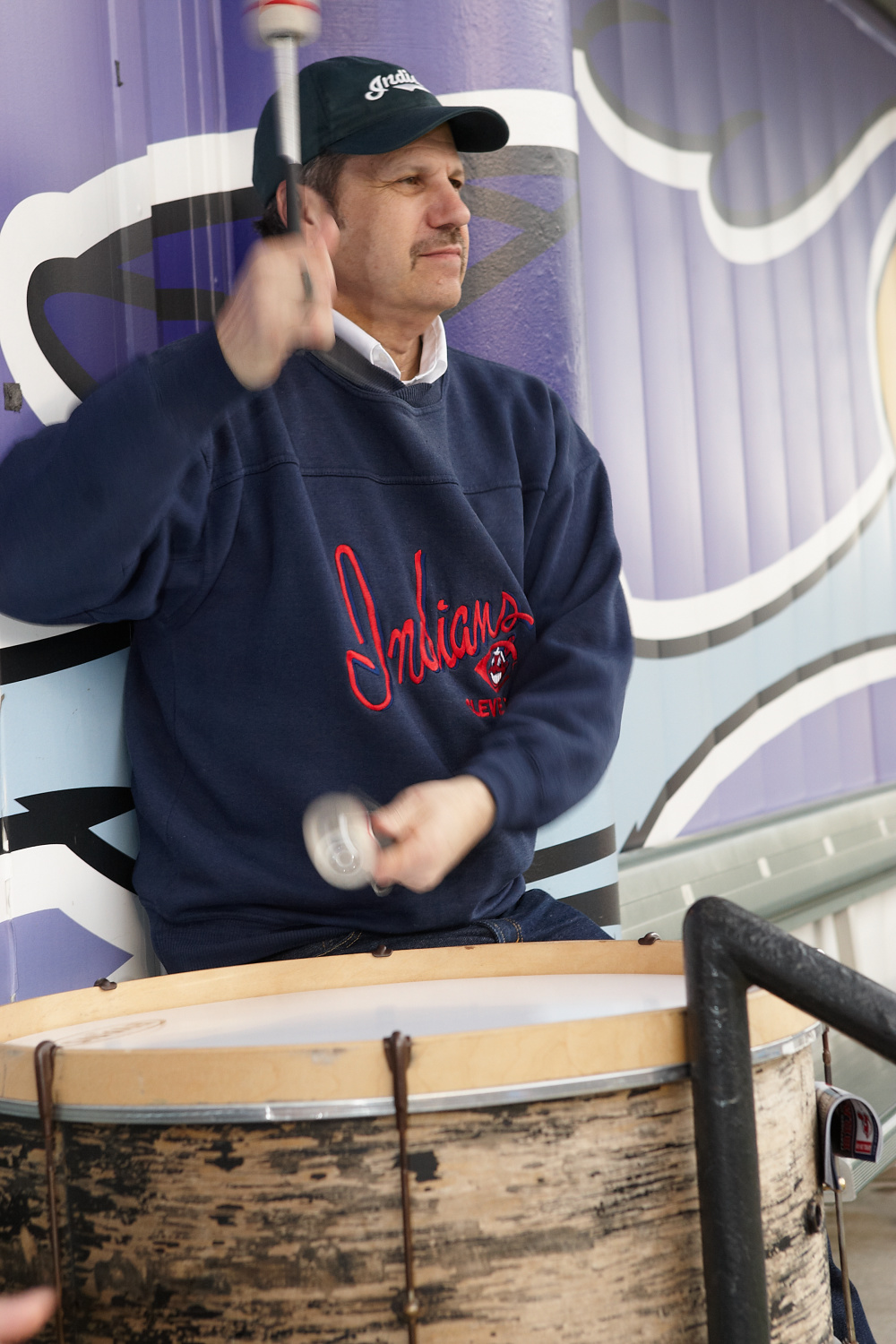August 24, 1973: Rare Duffy power surge gives Cleveland a win in John Adams’ debut on drums
 There wasn’t a lot on the line when the Cleveland Indians and Texas Rangers met on August 24, 1973, at Cleveland Stadium.
There wasn’t a lot on the line when the Cleveland Indians and Texas Rangers met on August 24, 1973, at Cleveland Stadium.
The Rangers had relocated from Washington a season earlier and were in the midst of one of what journalist Mike Shropshire, who covered the team for the Fort Worth Star-Telegram, referred to in his memoir as the “seasons in hell.”1 They were dead last in the American League West division, 15 games behind the next closest team, the Chicago White Sox.
The Indians had dug their own grave in the first half of the season, but were playing at a good enough clip—they were over .500 since the All-Star break—that owner Nick Mileti saw fit to give manager Ken Aspromonte a vote of confidence that he’d be in the Indians’ dugout again the following season.2
But in the years to come, the game became notable for the emergence of one of Cleveland’s most enduring superfans, one of the robust crowd of 5,736 on that Friday night, well below average even by the low standards for that season.3
John Adams, a 21-year-old Cleveland State University student and employee at Ohio Bell, brought with him a bass drum from a drum kit he’d bought for $25—“and that’s about what it was worth,” he recalled in an interview years later.4
As a kid sitting in the grandstand, he would bang the seats up and down to make noise. That option was not available in the bleachers, so he brought his drum—asking first to see if it would be OK. “As long as you don’t annoy anybody,” came the response from Indians PR director Dino Lucarelli.
When Adams took the drum into the bleachers, a police officer asked his plans. Adams said he was going to beat the drum, and Dino said he could. “OK,” the cop said. “Who’s Dino?”5
The game was scoreless until the bottom of the second. With one out, the Indians’ Walt Williams was hit by pitcher Don Durham, who had stepped in for Sonny Siebert, a late scratch with a sore arm. Williams stole second and went to third on a bad throw by catcher Ken Suarez.
One out later, Rusty Torres walked. Frank Duffy, who began the night with just three career homers in 251 major-league games, hit a home run over the left-field fence, giving the Indians a 3-0 lead.
The Rangers got on the scoreboard in the top of the third, when Dave Nelson singled off Tom Timmermann. He moved to third after a steal attempt and a throwing error by Indians catcher Dave Duncan, and came home on a groundout by Toby Harrah.
After Durham set the Indians down in order in the bottom half of the frame, the Rangers continued to chip away at the Indians’ lead. Alex Johnson led off the top of the fourth with a home run. Jeff Burroughs drew a walk off Timmermann and Bill Sudakis grounded out, sending Burroughs to second. Larry Biittner singled to advance Burroughs to third.
Vic Harris tripled, scoring Burroughs and Biittner and giving the Rangers the lead. Suarez then grounded out to score Harris. Nelson singled, but Harrah grounded out to end the inning with the Rangers leading 5-3.
With one out in the bottom of the fifth, Duffy struck again, homering off Durham. “Nobody expects me to hit home runs,” Duffy said afterward. “In fact, nobody expects me to do anything.”6
Duffy had come to Cleveland after the 1971 season, an additional piece in the deal that sent Sam McDowell to San Francisco for Gaylord Perry, who had won the AL Cy Young Award in his first year in Cleveland. Duffy’s emergence as the everyday shortstop in the second half of the 1973 season was heralded as one of the main reasons for the Indians’ resurgence.7
Duffy’s home run opened the floodgates. After Buddy Bell grounded out, Ron Lolich, pinch-hitting for Oscar Gamble, drew a walk. Chris Chambliss doubled to score Lolich and tie the game. Duncan then singled to score Chambliss, and Jackie Brown replaced Durham on the mound.
Charlie Spikes took first on a dropped third strike, and Brown gave up an RBI single to Williams, who like Duffy was producing better as he received more playing time.8 Charlie Hudson relieved Brown and got Jack Brohamer to ground out, ending the inning.
Hudson got into a jam in the bottom of the seventh, giving up a double to Lolich and walking Duncan, with a groundout by Chambliss in between. Spikes singled, scoring Lolich, and with one out, one run in, and runners at the corners, Hudson was done.
Bill Gogolewski relieved and gave up a single to Williams, scoring Duncan and moving pinch-runner Mike Kekich—regularly a pitcher9—to second. Brohamer hit a grounder to second baseman Nelson, who flipped the ball to Harrah to force out Williams. But Williams was able to break up a potential inning-ending double play, and Kekich moved to third base.
Gogolewski uncorked a wild pitch to Torres, and Kekich came home, with Brohamer moving to second. With first base open, Gogolewski intentionally walked Torres, and up stepped the hero of the day, Frank Duffy. He grounded out to end the inning, but the Indians had a 10-5 lead.
The Indians tacked on another run in the eighth, again by breaking up a potential double play. With Chambliss at first and Bell at second, Duncan hit a grounder to third. Chambliss was forced out, but the double play couldn’t be finished. Meanwhile, Bell came around from second to complete the scoring.
It was the Rangers’ 14th loss in 15 games. “We’ve had a hard time of it,” said manager Whitey Herzog,10 who was fired about two weeks later when the Rangers had the chance to hire Billy Martin, himself recently fired by the Tigers.
After the fourth inning, Timmermann gave up just one walk and no more hits, going the distance for the win.
“That fourth inning could have been a problem,” he said. “It seems like the whole year I’ve had one bad streak in a game and could never recover.”11
Adams’s drumbeat could be heard throughout the ballpark at key times, from when the Rangers bullpen started warming up to the Indians’ rally. After the game, Cleveland Press writer Bob Sudyk tracked down Adams, who said he’d combined his two loves: drumming and the Indians. In the following Monday’s paper, Sudyk said Adams would be at that night’s game.
Adams didn’t want to make a liar out of him, so he went—and continued to go. Adams, who died on January 30, 2023, estimated he and his drum attended more than 3,800 games between 1973 and at the end of the 2019 season.12
Acknowledgments
This article was fact-checked by Eric Katz and copy-edited by Len Levin.
Sources and Photo Credit
In addition to the sources cited in the Notes, the author consulted Baseball-Reference.com and Retrosheet.org for pertinent information, including the box score and play-by-play.
https://www.baseball-reference.com/boxes/CLE/CLE197308240.shtml
https://www.retrosheet.org/boxesetc/1973/B08240CLE1973.htm
Photo of John Adams banging the drums at Progressive Field in 2011 is courtesy of the Cleveland Guardians.
Notes
1 In Shropshire’s book, that era spanned from 1973 to 1975.
2 Bob Sudyk, “The Tribe’s Newest Hero? Frank (Home Run) Duffy,” Cleveland Press, August 25, 1973: C-1.
3 The Indians drew a total of 615,107 fans that season—with more than 10 percent of that coming from the Opening Day crowd. Average attendance was 7,594.
4 2016 interview with Dan Coughlin for the Cleveland Public Library Sports Icon series. https://www.youtube.com/watch?v=gRXtTymWrq8.
5 Bob Sudyk, “Tub Thumper: Bleacherite Drums Up Enthusiasm for Indians,” Cleveland Press, August 27, 1978: C-1. In addition to the Indians, Dino Lucarelli worked in media relations for the AHL Cleveland Barons. He’s most notable for his years with the NFL’s Cleveland Browns. The Cleveland Pro Football Writers Association chapter’s annual Good Guy Award is named for him.
6 Sudyk, “The Tribe’s Newest Hero? Frank (Home Run) Duffy.”
7 Russell Schneider, “Duffy Proves Himself—Again,” Cleveland Plain Dealer, August 24,1973: 1-E.
8 As of July 10, Williams was hitting .220. He finished the season at .289.
9 Kekich, who’d been dealt from Yankees early in the season after his family swap with Fritz Peterson, was pitching miserably at the time (7.20 ERA with Cleveland as of August 24) and thus available to pinch-run. He hadn’t taken the mound in a week and didn’t pitch again until August 31. He was used as a pinch-runner three times in late August and early September
10 Richard Billotti, “Duffy Belts 2 Home Runs in Tribe’s 11-5 Victory,” Dover (Ohio) Daily Reporter, August 25, 1973: B-2.
11 Billotti.
12 Adams was offered the opportunity to attend games during the pandemic season in 2020 but declined. Health problems started to take a toll after that. Richard Sandomir, “John Adams, Who Banged His Drum Loudly in Cleveland, Dies at 71,” New York Times, February 1, 2023, https://www.nytimes.com/2023/02/01/sports/baseball/john-adams-dead.html.
Additional Stats
Cleveland Indians 11
Texas Rangers 5
Cleveland Stadium
Cleveland, OH
Box Score + PBP:
Corrections? Additions?
If you can help us improve this game story, contact us.


